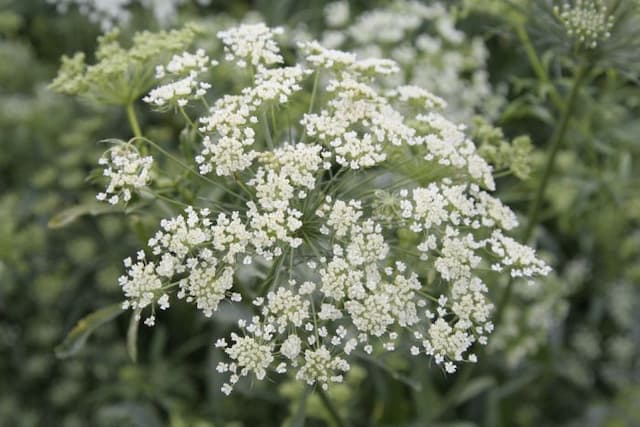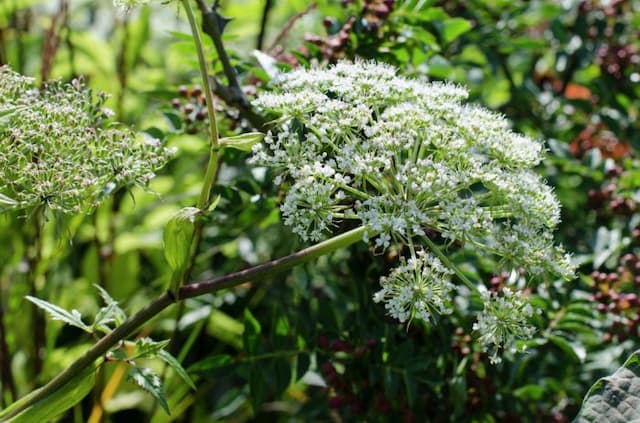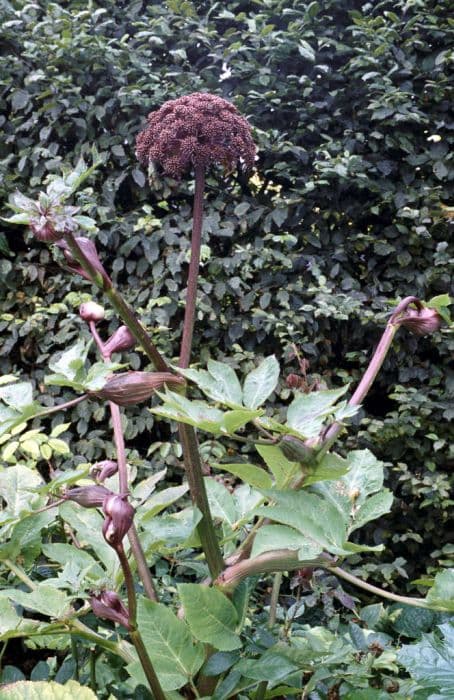Eryngium Dove Cottage hybrid

ABOUT
The Eryngium Dove Cottage hybrid, commonly known as Sea Holly, is a striking perennial plant renowned for its distinctive appearance. It features a rosette of spiny, dark green leaves with a silvery-blue hue, giving it a somewhat metallic gleam. These leaves are deeply cut, almost resembling holly foliage, which is where its common name derives. An arresting aspect of Sea Holly is its flower heads, which bloom in a stunning shade of steel blue, surrounded by several slender bracts that may have a similar color or sometimes show a hint of green. These bracts are spiky and add to the plant's textural interest. The flower heads are small and clustered, forming cone-like shapes that rise above the foliage on stiff, branched stems. The inflorescences of the Sea Holly are strikingly architectural, making them highly prized for both fresh and dried floral arrangements. They draw the eye in the garden with their unique coloration and form. Furthermore, blooms of the Sea Holly can persist through a good portion of the summer, providing extended visual interest. Additionally, the Sea Holly attracts a variety of wildlife, including bees and butterflies, adding an extra layer of dynamic energy to its presence in any garden setting. Its appearance is not only ornamental but also beneficial for supporting local ecosystems. With its hardy nature and unique aesthetics, the Sea Holly is a popular choice among gardeners looking to add a touch of drama and a hint of the coast to their landscapes.
About this plant
 Names
NamesFamily
Apiaceae
Synonyms
Sea Holly, Eryngo
Common names
Eryngium Dove Cottage hybrid
 Toxicity
ToxicityTo humans
The Sea Holly is not known to be toxic to humans. Therefore, ingestion of parts of this plant typically does not result in poisoning or adverse health effects.
To pets
Similarly, Sea Holly is not recognized as a toxic plant to pets such as dogs and cats. If a pet ingests parts of this plant, it is not expected to experience symptoms of poisoning or suffer serious consequences due to toxicity. However, ingestion of non-food items can sometimes lead to gastrointestinal upset or obstruction, so it is generally recommended to prevent pets from consuming plants not meant for their consumption.
 Characteristics
CharacteristicsLife cycle
Perennials
Foliage type
Deciduous
Color of leaves
Varies
Flower color
Varies
Height
2 feet (60 cm)
Spread
1 foot (30 cm)
Plant type
Herb
Hardiness zones
5
Native area
Europe
Benefits
 General Benefits
General Benefits- Attracts Pollinators: Eryngium Dove Cottage hybrid, also known as Sea Holly, encourages bees and butterflies to visit your garden, aiding in pollination of surrounding plants.
- Drought Tolerance: Once established, it requires minimal water, making it ideal for xeriscaping and water-wise gardens.
- Deer Resistance: The plant's spiny foliage deters deer, making it a good choice for gardens in areas with active deer populations.
- Long Blooming: Sea Holly has a long flowering season, often blooming from early summer through to fall, providing extended visual interest.
- Unique Texture: Its thistle-like appearance adds an interesting texture, setting it apart from other plants in the garden.
- Low Maintenance: This hybrid generally requires little care once established, thus suitable for low-maintenance landscapes.
- Ornamental Value: With striking blue or silvery flowers and architectural form, it’s highly valued for its ornamental appeal.
- Cut Flowers: The flowers and stems are excellent for cutting and retain their color when dried, making them ideal for floral arrangements.
 Medical Properties
Medical PropertiesThis plant is not used for medical purposes.
 Air-purifying Qualities
Air-purifying QualitiesThis plant is not specifically known for air purifying qualities.
 Other Uses
Other Uses- Eryngium 'Dove Cottage Hybrid', commonly known as Sea Holly, can be used in floral art and dried flower arrangements due to its distinctively spiky texture and long-lasting color.
- Sea Holly serves as an intriguing focal point in rock gardens, adding architectural interest with its striking form and foliage.
- The metallic-blue stems and flower heads of Sea Holly can be used to create natural dyes for fabric, offering subtle and unique color variations.
- Due to its robust nature, Sea Holly is suitable for stabilizing sandy soils or coastal erosion control where its deep roots help bind the soil.
- Sea Holly’s structural appearance provides excellent contrast in mixed perennial borders, enhancing the garden design with its unique shape.
- The resilient nature of Sea Holly allows it to be used in xeriscaping, contributing to water conservation in landscapes.
- Eryngium 'Dove Cottage Hybrid' can be planted to create a naturalistic, wild garden atmosphere, attracting pollinators such as bees and butterflies.
- The thistle-like appearance of Sea Holly can be featured in fashion photography or costume design, where elements of nature are incorporated for visual impact.
- Because of its unique look, Sea Holly can be used as an educational tool in botanical studies to demonstrate plant adaptations in different ecosystems.
- The spiny leaves and stems of Sea Holly can act as a natural deterrent in the garden, deterring small animals from nibbling on more delicate plants.
Interesting Facts
 Feng Shui
Feng ShuiThe Sea Holly is not used in Feng Shui practice.
 Zodiac Sign Compitability
Zodiac Sign CompitabilityThe Sea Holly is not used in astrology practice.
 Plant Symbolism
Plant Symbolism- Determination: Eryngium, commonly known as Sea Holly, is known for its hardy nature and ability to grow in challenging conditions, representing determination and tenacity.
- Independence: The spiky appearance of Sea Holly suggests a self-reliant, somewhat defensive character, symbolizing the value of independence.
- Attraction: Historically, Sea Holly was believed to be an aphrodisiac, making it a symbol of attraction and allure.
- Protection: The prickly texture of the plant gives the impression of a natural armor, thus symbolizing protection from harm or negativity.
 Water
WaterSea holly prefers to be watered deeply but infrequently, fostering strong root development. Allow the top inch of soil to dry out before watering again. Typically, this means watering once every week or two, depending on the climate and weather conditions. Aim for about one gallon of water per plant for each watering session. During prolonged dry spells or in particularly hot climates, monitor the soil moisture level more frequently to ensure the plant does not become too dry.
 Light
LightSea holly thrives in full sun conditions where it can receive at least six to eight hours of direct sunlight daily. The best spot for the plant is an area that is exposed to unfiltered sunlight throughout the day, which helps to promote strong growth and vibrant flowers. This plant does not fare well in shady areas, as insufficient light can lead to weak growth and fewer blooms.
 Temperature
TemperatureSea holly is hardy and can tolerate a range of temperatures but performs best in conditions between 60°F and 80°F. It can survive minimum temperatures down to around 0°F, making it suitable for many temperate climates. However, it should be protected from extreme cold and frost, which can damage the plant.
 Pruning
PruningSea holly should be pruned to remove spent flowers and encourage further blooming. Deadheading the faded blooms can be done throughout the flowering season. Prune old flower stems back to the ground in late fall or early spring to maintain a tidy appearance and promote healthy growth for the next season. There's no need for frequent pruning aside from these maintenance practices.
 Cleaning
CleaningAs needed
 Soil
SoilSea holly thrives in well-draining soil with a pH ranging from slightly acidic to neutral. The best soil mix for Sea Holly is a blend of garden soil, coarse sand, and compost, ensuring good drainage. A pH of 5.5 to 7.0 is ideal for optimal growth.
 Repotting
RepottingSea Holly, or Eryngium Dove Cottage hybrid, typically does not require frequent repotting. Repot every 2-3 years or when it outgrows its current container to maintain its health and vigor.
 Humidity & Misting
Humidity & MistingSea Holly prefers a dry to moderate humidity environment and is tolerant of drought-like conditions once established. Best humidity level is considered to be between 40% to 60%.
 Suitable locations
Suitable locationsIndoor
Place Sea Holly in bright light, with well-draining soil.
Outdoor
Plant Sea Holly in full sun, well-drained soil, space 12 inches apart.
Hardiness zone
5-9 USDA
 Life cycle
Life cycleThe plant commonly known as Sea Holly 'Dove Cottage' hybrid (Eryngium) begins its life cycle as a seed, which is sown in fertile, well-draining soil, often during spring after the threat of frost has passed. Upon germination, the seedling emerges and develops a rosette of coarse, spiny leaves at the base. As it matures, Sea Holly produces a rigid, branched stem and distinctive, spiky, cone-shaped flower heads surrounded by a ruff of bracts, which are often metallic blue, in the summer. After pollination by insects attracted to its striking blooms, the plant sets seed, which can be collected if desired or allowed to self-sow. Sea Holly can be a short-lived perennial or biennial, and after a few years, it may decline, at which point it completes its life cycle and dies. The Sea Holly may also be propagated through division in early spring or autumn to rejuvenate and spread the plant.
 Propogation
PropogationPropogation time
Late spring to early summer
The Sea Holly, known specifically as the Eryngium 'Dove Cottage' hybrid, is commonly propagated through seed. The most favorable time to propagate Sea Holly by seeds tends to be in late winter or early spring. The process involves sowing the seeds thinly onto well-drained soil in a tray and covering them lightly with a sprinkling of soil. The tray should be placed in a cold frame or a similarly sheltered environment, and kept moist. Germination can be slow and erratic, often taking several weeks, and sometimes improved with a period of stratification, which means placing the seed tray in a fridge for a couple of weeks to simulate winter conditions. Once the seedlings have developed true leaves and are large enough to handle, they can be transplanted into individual pots. It's important to handle the young plants carefully, especially being gentle with the root system, as they can be sensitive to disturbance.









